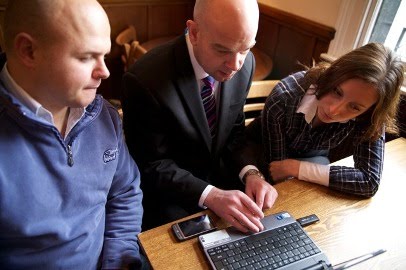Tuesday, 24 November 2009
Cast your net wider for a bigger catch - adding podcasts to your comms mix
I've been threatening to write a blog on podcasts for a while so here it is! Podcasts are somewhat neglected by internal communications professionals perhaps because of fear that lots of tech is involved, but actually they are not that geeky and once set up podcasting is a quick and easy process.
If you're not familiar with the concept I suggest you subscribe to a 'real world' podcast to become familar with the concept. The BBC have a wide selection in their podcast directory.
As you'll see below podcasts can be great addition to the internal communications mix and can provide a new, informal and engaging channel for employees.
A podcast is an MP3 file recording of a person or persons delivered via RSS feed, usually in the style of a presentation or radio show. In contrast to a standard sound file the key aspect of a podcast is the RSS feed. This enables it to be automatically synched to a portable digital player, such as iPod/iPhone, a MP3 player or a PC or laptop.
A listener can subscribe to a podcast to hear it immediately and then, when a new instalment/recording is available, this is automatically retrieved and transferred to the MP3 player ready for playback. The subscriber can then play the file at their leisure. The recording can also be played or downloaded directly by selecting a link to the MP3 file on an intranet or web page.
The most common method of recording podcasts is using a microphone and headset in conjunction with PC recording software such as Sound Recorder or Audacity.
The most difficult and technical part of podcasting is setting up the RSS feed. If you need help with this then speak to your IT people or contact me. Once your RSS feed (suggest this is named rss.xml) and podcast are ready they will need to be placed in a location that's accessible by all employees. The logical place is therefore the intranet server and again you might need help with IT on uploading it there. Each time a new podcast is created it will need to be placed in the podcast location and the RSS file amended.
Advantages
Personal - employees get to hear a real voice and person rather than a bland toneless email. It's a great channel for an informal and human approach. The message or information is therefore more engaging and more likely to be taken on board...so can help communications be successful.
Flexible - a podcast can be synched to a portable device eg iPhone and listened to anywhere and at any time the listener chooses. So for busy workers it can be a great way to catch up on internal comms during dead time such as when waiting for a train/plane, travelling to a meeting etc.
Easy to produce - podcasts are easy and quick to produce. (see hints and tips below).
Large potential audience - there is no limit to the audience and large audiences aren't more difficult. For example, the effort and resources to produce a podcast for 100 employees is the same as for 100,000 employees.
Hints and tips
Low budget solutions - If you are low on budget and have access to a voice conferencing service such as InterCall you can use that to make a recording. This is easy to record using a telephone. The file is then converted to .mp3 format (using a sound recorder like Audacity) so that it's suitable for podcast.
Quality solution - If you have budget, invest in a mic and recording software such as Samson C01U Recording and Podcasting Microphone Pak which is available on Amazon.
Integrate with other channels - podcasts should be considered as part of the whole internal communications strategy and integrated with other channels. For example, when you have a need to communicate add podcasts to the list of possible channels to use. You could also record a summary of the previous week or month's email announcements. If it's the latter then a member of the internal comms team can produce. This can be a quick win as no management buy-in is required.
Many uses - podcasts can be used for many purposes. Here are a few examples: by knowledge workers to transfer their specialist knowledge to others in the business, to train workers on IT matters, to inform workers about change eg new HR benefits etc, to inform employees about new products. I'm sure you can think of lots more.
Don't script for exec podcasts - unlike a CEO blog which can be ghosted (yes, most of them are) it's best to have the CEO use their own words and to speak how they would speak.
In summary, podcasting has valuable communication benefits and is easy to add to the list of communication channels that can be used by an internal communications team to help them achieve their objectives.
If you're not familiar with the concept I suggest you subscribe to a 'real world' podcast to become familar with the concept. The BBC have a wide selection in their podcast directory.
As you'll see below podcasts can be great addition to the internal communications mix and can provide a new, informal and engaging channel for employees.
A podcast is an MP3 file recording of a person or persons delivered via RSS feed, usually in the style of a presentation or radio show. In contrast to a standard sound file the key aspect of a podcast is the RSS feed. This enables it to be automatically synched to a portable digital player, such as iPod/iPhone, a MP3 player or a PC or laptop.
A listener can subscribe to a podcast to hear it immediately and then, when a new instalment/recording is available, this is automatically retrieved and transferred to the MP3 player ready for playback. The subscriber can then play the file at their leisure. The recording can also be played or downloaded directly by selecting a link to the MP3 file on an intranet or web page.
The most common method of recording podcasts is using a microphone and headset in conjunction with PC recording software such as Sound Recorder or Audacity.
The most difficult and technical part of podcasting is setting up the RSS feed. If you need help with this then speak to your IT people or contact me. Once your RSS feed (suggest this is named rss.xml) and podcast are ready they will need to be placed in a location that's accessible by all employees. The logical place is therefore the intranet server and again you might need help with IT on uploading it there. Each time a new podcast is created it will need to be placed in the podcast location and the RSS file amended.
Advantages
Personal - employees get to hear a real voice and person rather than a bland toneless email. It's a great channel for an informal and human approach. The message or information is therefore more engaging and more likely to be taken on board...so can help communications be successful.
Flexible - a podcast can be synched to a portable device eg iPhone and listened to anywhere and at any time the listener chooses. So for busy workers it can be a great way to catch up on internal comms during dead time such as when waiting for a train/plane, travelling to a meeting etc.
Easy to produce - podcasts are easy and quick to produce. (see hints and tips below).
Large potential audience - there is no limit to the audience and large audiences aren't more difficult. For example, the effort and resources to produce a podcast for 100 employees is the same as for 100,000 employees.
Hints and tips
Low budget solutions - If you are low on budget and have access to a voice conferencing service such as InterCall you can use that to make a recording. This is easy to record using a telephone. The file is then converted to .mp3 format (using a sound recorder like Audacity) so that it's suitable for podcast.
Quality solution - If you have budget, invest in a mic and recording software such as Samson C01U Recording and Podcasting Microphone Pak which is available on Amazon.
Integrate with other channels - podcasts should be considered as part of the whole internal communications strategy and integrated with other channels. For example, when you have a need to communicate add podcasts to the list of possible channels to use. You could also record a summary of the previous week or month's email announcements. If it's the latter then a member of the internal comms team can produce. This can be a quick win as no management buy-in is required.
Many uses - podcasts can be used for many purposes. Here are a few examples: by knowledge workers to transfer their specialist knowledge to others in the business, to train workers on IT matters, to inform workers about change eg new HR benefits etc, to inform employees about new products. I'm sure you can think of lots more.
Don't script for exec podcasts - unlike a CEO blog which can be ghosted (yes, most of them are) it's best to have the CEO use their own words and to speak how they would speak.
In summary, podcasting has valuable communication benefits and is easy to add to the list of communication channels that can be used by an internal communications team to help them achieve their objectives.
Quality picks
- Best Non Gamstop Casinos
- Non Gamstop Casinos UK
- Casino Sites Not On Gamstop
- UK Online Casinos Not On Gamstop
- Lista Casino Non Aams
- Betting Sites That Are Not On Gamstop
- Best Online Casinos
- UK Casino Not On Gamstop
- UK Casino Not On Gamstop
- Non Gamstop Casinos
- Non Gamstop Casinos
- Trusted Non Gamstop Casinos
- UK Online Casinos Not On Gamstop
- カジノ オンライン
- Best Casino Sites Not On Gamstop 2025
- Casino Sites Not On Gamstop
- Non Gamstop Casino Sites UK
- Sites Not On Gamstop
- Casino En Ligne
- Meilleur Casino En Ligne France
- Casinos Not On Gamstop
- Betting Site
- Migliore Casino Non Aams
- Best Sports Betting Sites Not On Gamstop
- Bitcoin Casinos
- Casino En Ligne
Subscribe to:
Post Comments (Atom)











1 comments:
Virtual Studio is the pioneer web cast streaming service provider company in India based out of New Delhi, having web cast for various corporates and multinationals, a number of events of international importance. Starting from being the official webcasters of the ‘Pop John Pall’s visit to India in 1999; they have covered it all from Bill Clinton to Bill Gates. International Events such as Executive Assembly of World Energy Council to Multi Location simulcast of Golden Jublee Celebration of Cardio Thoracic Surgeons. Live Series of Technology Programs for MSN to whole of Cricket series including ICC World Cup 2003 to 2007; T20; Gavaskar Border Series 2008(India vs Australia); ICL; IPL 2009. Dreamspark launch by Bill Gates at IIT Delhi. Live streaming of 10 Channels of World Space satellite radio. And scores of live and on demand streaming web casts in between. For all streaming needs including live streaming services from India, the leading live streaming services provider is also providing on demand streaming services. In fact Virtual Studio is a preferred web cast streaming media company with its head office based in Delhi.
Post a Comment